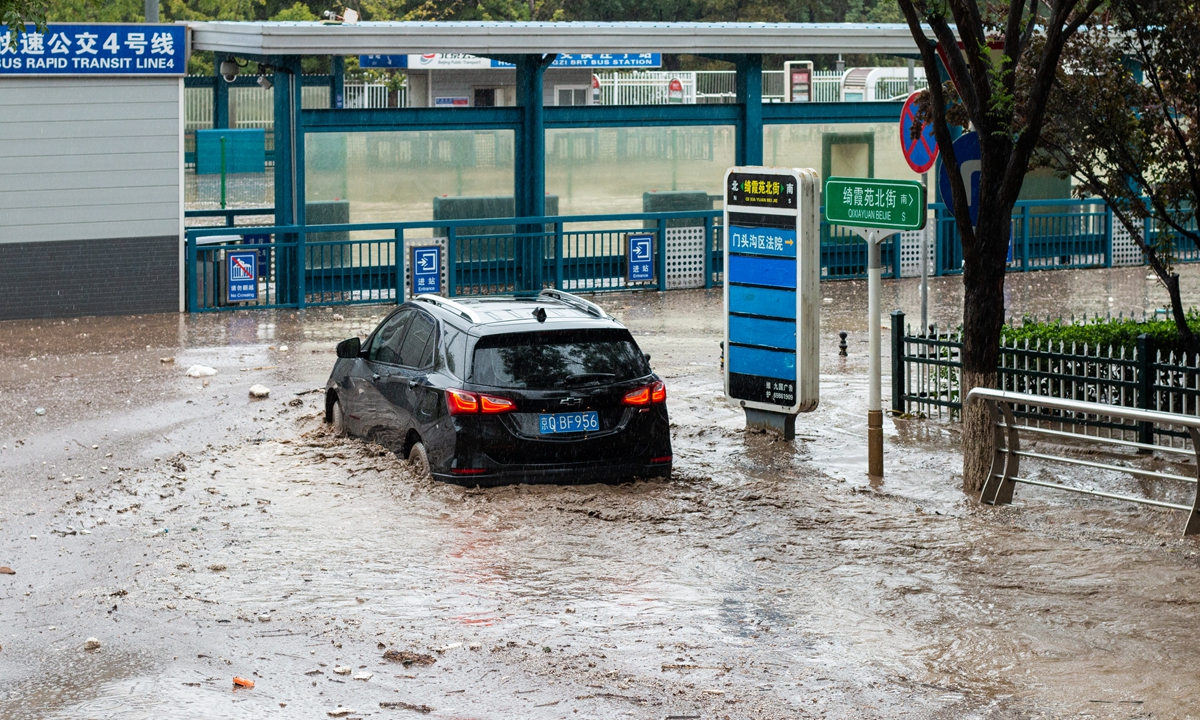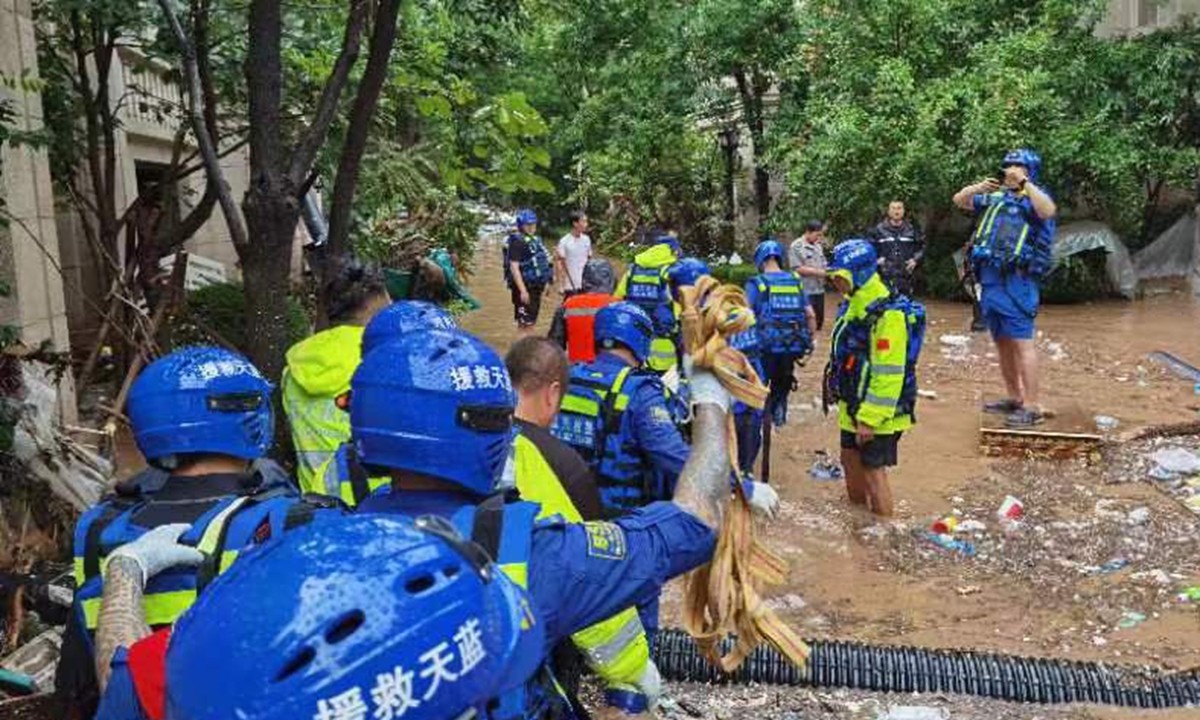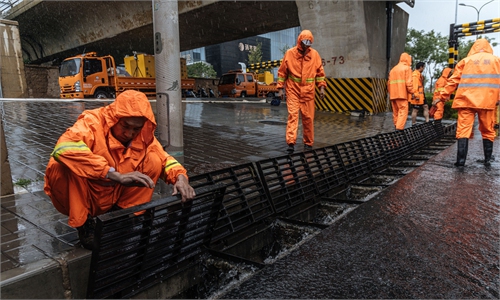Two found dead in Beijing suburb heavy rainfall, flooding; 5,000 residents evacuated

A car plows through a flooded street in Mentougou district, Beijing, on July 31, 2023. Photo: IC
Two people were found dead in the western Beijing district of Mentougou following days of unrelenting heavy rain, the People's Daily reported on Monday afternoon. Since Sunday, Mentougou, along with other outlying districts of the Chinese capital, has experienced one of the heaviest rainfalls in the past decade.
Between 8 am Saturday and 6 am Monday, the city's average precipitation was 138.3 mm, with a total of 2.097 billion cubic meters of precipitation. The average rainfall in the city reached the level of the July 21, 2012 storm, which took the lives of 79 people, but the average rainfall in both Fangshan and Mentougou districts reached 400 millimeters, much higher than "July 21," said Liu Bin, deputy commander of Beijing Municipal Flood Control Office.
Many videos circulating online show that days of heavy rainfall led to flash floods and waterlogging in the suburbs and mountainous areas across western Beijing, especially Mentougou.
Data from the Beijing municipal flood control department shows that throughout the city, more than 52,384 people who were affected by flooding were transferred to safety as of 8 pm on Monday. Flooding has forced the closure of 107 mountain roads.
According to Beijing's flood control office, rainfall caused waterlogging and damaged roads in many sections of Mentougou, as well as landslides and flash flooding.
Beijing Municipal Meteorological Observatory on Monday issued a red warning signal for rainstorms in some regions, while Beijing Hydrological Station upgraded its red warning for floods on Monday morning.
On Monday afternoon, Beijing upgraded the red warning for meteorological risks of geological disasters. Up to Wednesday, Fangshan, Mentougou and Fengtai districts in Beijing are at high risk of geological disasters such as collapses, landslides and mudslides.
According to videos sent to the Global Times on Monday from residents in Mentougou, many people are awaiting rescue on higher ground, and many cars have been swept away by rushing floodwaters.
Several other videos taken in Mentougou showed that water had flooded a bridge and poured into some restaurants and large supermarkets.
A resident surnamed Lu, who lives in Mentougou, told the Global Times that tap water supply had been cut off to residential buildings for several hours due to flooding.
The Global Times learned from Beijing Blue Sky Rescue, a Chinese civil relief squad, that it has dispatched a 32-strong emergency rescue team to the mountainous areas of Mentougou. As of Monday afternoon, the rescue team has successfully transported more than 100 people out of danger.

Members of the Beijing Blue Sky Rescue, a Chinese civil relief squad, carry out a rescue in Fangshan district, Beijing on July 31, 2023 in heavy rainfall. Photo: Courtesy of the Beijing Blue Sky Rescue
In addition to Mentougou, other suburban areas of Beijing, including Fangshan and Daxing, have also been seriously affected by the rainfall.
Two river basins in Fangshan district have overflowed their banks, and there are many dangerous situations along the river. On Monday morning, a road near a village in Fangshan was washed away, blocking access to the village.
Emergency management authorities in Fangshan district confirmed to the Global Times that it has received reports of residents trapped due to heavy rain and floods since Monday morning. The district government has sent out all rescue forces available.
According to latest reports from district rescue authorities, more than 100 residents who were stranded in Fangshan have been rescued.
Communications have been disrupted across wide swaths of Mentougou district, and due to the power outages in the mountain areas, as well as the inundated roads, work to repair communications will begin on Tuesday, media reported.
A Beijing resident who traveled from downtown to Daxing district on Monday morning told the Global Times the water had flooded some underground tunnels. She had to take the subway back to the city as traffic was paralyzed.
Two trains were stranded on Monday due to landslides caused by heavy rains, with more than 1,900 passengers and crew disembarking and being moved to safety. A subway line to Fangshan was suspended due to heavy rain.
Some weather stations in Mentougou and Fangshan have experienced power and communication base station failures that disrupted data updates, according to monitoring information released by Chinese weather analyst Xin Xin on Monday night, which means the actual precipitation could be higher than the current data. This type of outage did not happen even during the two heavy rainstorms in 2012 and 2016, observers noted.
On Monday night, Beijing once again issued a red warning for rainstorm. According to forecasts, the downtown districts of Dongcheng and Xicheng will be hit by heavy precipitation with hourly rainfall of 100 mm or more.
The Municipal Flood Control Office on Monday again reminded residents that rainfall is forecast to continue for Monday and Tuesday, and the city is at a level-I response for flooding risk. Beijing residents are again reminded to stay indoors and avoid activities in mountainous areas, rivers, and areas of potential geological hazards.
The NMC on Monday morning maintained the highest-level red alert for rainstorms for the third consecutive day as provinces and regions close to Beijing are forecast to be gripped by extreme rainfall.
The red alert was activated for only the second time since 2010.
Sun Shao, a senior researcher at the Chinese Academy of Meteorological Sciences, told the Global Times that the extreme rainfall in Beijing and surrounding areas. Is because after Typhoon Doksuri's landfall in Fujian Province last Friday, a nearly square-shaped anticyclone formed on its eastern side, guiding the residual circulation to move northward and continue producing rainfall.
As it progressed northward, the atmospheric circulation pattern underwent changes, leading to the anticyclone connecting with another high-pressure ridge in the west, forming a formidable "high-pressure dam" that hindered Doksuri's northward movement. Weakened by land friction, Doksuri was unable to break through the barrier and slowed down significantly in the North China region.
Simultaneously, a strong jet stream formed between the residual circulation of Doksuri and the anticyclone on its northeast side, continuously transporting moisture from the sea to North China, providing abundant "raw material" for persistent rainfall. As the jet stream encountered geographical features such as Taihang Mountain and Yanshan Mountain, it was forced to ascend, causing the water vapor to condense into rain, further enhancing the intensity of the heavy precipitation. The combined influences of atmospheric circulation and topography allowed the residual circulation of Doksuri to maintain its presence and continue generating extreme heavy rainfall in the North China region, even though it is far from where it made landfall in the country's southeast, Sun said.


